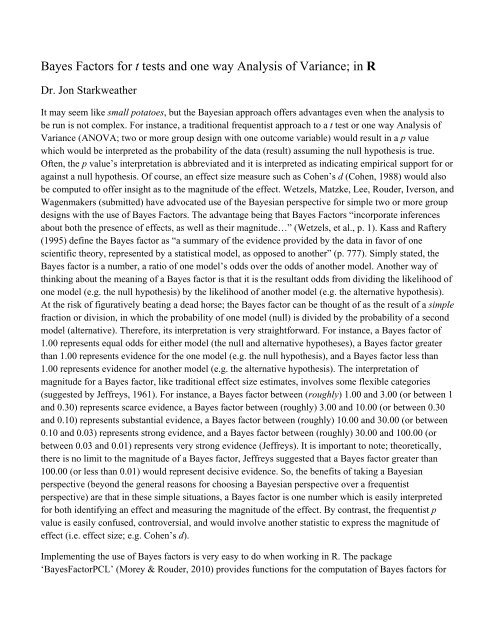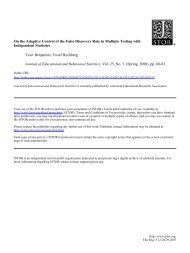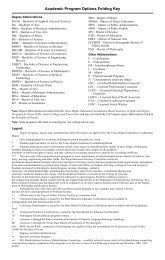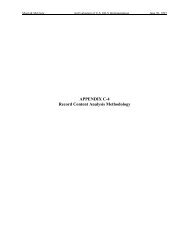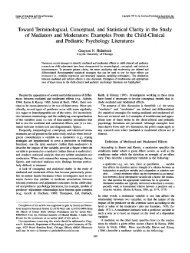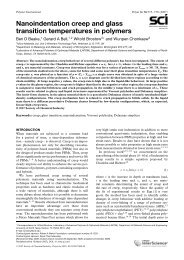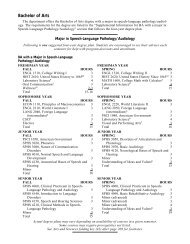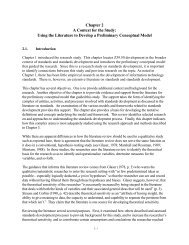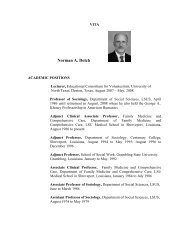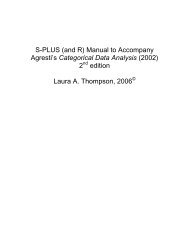Bayes Factors for t tests and one way Analysis of Variance; in R
Bayes Factors for t tests and one way Analysis of Variance; in R
Bayes Factors for t tests and one way Analysis of Variance; in R
Create successful ePaper yourself
Turn your PDF publications into a flip-book with our unique Google optimized e-Paper software.
<strong>Bayes</strong> <strong>Factors</strong> <strong>for</strong> t <strong>tests</strong> <strong>and</strong> <strong>one</strong> <strong>way</strong> <strong>Analysis</strong> <strong>of</strong> <strong>Variance</strong>; <strong>in</strong> RDr. Jon StarkweatherIt may seem like small potatoes, but the <strong>Bayes</strong>ian approach <strong>of</strong>fers advantages even when the analysis tobe run is not complex. For <strong>in</strong>stance, a traditional frequentist approach to a t test or <strong>one</strong> <strong>way</strong> <strong>Analysis</strong> <strong>of</strong><strong>Variance</strong> (ANOVA; two or more group design with <strong>one</strong> outcome variable) would result <strong>in</strong> a p valuewhich would be <strong>in</strong>terpreted as the probability <strong>of</strong> the data (result) assum<strong>in</strong>g the null hypothesis is true.Often, the p value’s <strong>in</strong>terpretation is abbreviated <strong>and</strong> it is <strong>in</strong>terpreted as <strong>in</strong>dicat<strong>in</strong>g empirical support <strong>for</strong> oraga<strong>in</strong>st a null hypothesis. Of course, an effect size measure such as Cohen’s d (Cohen, 1988) would alsobe computed to <strong>of</strong>fer <strong>in</strong>sight as to the magnitude <strong>of</strong> the effect. Wetzels, Matzke, Lee, Rouder, Iverson, <strong>and</strong>Wagenmakers (submitted) have advocated use <strong>of</strong> the <strong>Bayes</strong>ian perspective <strong>for</strong> simple two or more groupdesigns with the use <strong>of</strong> <strong>Bayes</strong> <strong>Factors</strong>. The advantage be<strong>in</strong>g that <strong>Bayes</strong> <strong>Factors</strong> “<strong>in</strong>corporate <strong>in</strong>ferencesabout both the presence <strong>of</strong> effects, as well as their magnitude…” (Wetzels, et al., p. 1). Kass <strong>and</strong> Raftery(1995) def<strong>in</strong>e the <strong>Bayes</strong> factor as “a summary <strong>of</strong> the evidence provided by the data <strong>in</strong> favor <strong>of</strong> <strong>one</strong>scientific theory, represented by a statistical model, as opposed to another” (p. 777). Simply stated, the<strong>Bayes</strong> factor is a number, a ratio <strong>of</strong> <strong>one</strong> model’s odds over the odds <strong>of</strong> another model. Another <strong>way</strong> <strong>of</strong>th<strong>in</strong>k<strong>in</strong>g about the mean<strong>in</strong>g <strong>of</strong> a <strong>Bayes</strong> factor is that it is the resultant odds from divid<strong>in</strong>g the likelihood <strong>of</strong><strong>one</strong> model (e.g. the null hypothesis) by the likelihood <strong>of</strong> another model (e.g. the alternative hypothesis).At the risk <strong>of</strong> figuratively beat<strong>in</strong>g a dead horse; the <strong>Bayes</strong> factor can be thought <strong>of</strong> as the result <strong>of</strong> a simplefraction or division, <strong>in</strong> which the probability <strong>of</strong> <strong>one</strong> model (null) is divided by the probability <strong>of</strong> a secondmodel (alternative). There<strong>for</strong>e, its <strong>in</strong>terpretation is very straight<strong>for</strong>ward. For <strong>in</strong>stance, a <strong>Bayes</strong> factor <strong>of</strong>1.00 represents equal odds <strong>for</strong> either model (the null <strong>and</strong> alternative hypotheses), a <strong>Bayes</strong> factor greaterthan 1.00 represents evidence <strong>for</strong> the <strong>one</strong> model (e.g. the null hypothesis), <strong>and</strong> a <strong>Bayes</strong> factor less than1.00 represents evidence <strong>for</strong> another model (e.g. the alternative hypothesis). The <strong>in</strong>terpretation <strong>of</strong>magnitude <strong>for</strong> a <strong>Bayes</strong> factor, like traditional effect size estimates, <strong>in</strong>volves some flexible categories(suggested by Jeffreys, 1961). For <strong>in</strong>stance, a <strong>Bayes</strong> factor between (roughly) 1.00 <strong>and</strong> 3.00 (or between 1<strong>and</strong> 0.30) represents scarce evidence, a <strong>Bayes</strong> factor between (roughly) 3.00 <strong>and</strong> 10.00 (or between 0.30<strong>and</strong> 0.10) represents substantial evidence, a <strong>Bayes</strong> factor between (roughly) 10.00 <strong>and</strong> 30.00 (or between0.10 <strong>and</strong> 0.03) represents strong evidence, <strong>and</strong> a <strong>Bayes</strong> factor between (roughly) 30.00 <strong>and</strong> 100.00 (orbetween 0.03 <strong>and</strong> 0.01) represents very strong evidence (Jeffreys). It is important to note; theoretically,there is no limit to the magnitude <strong>of</strong> a <strong>Bayes</strong> factor, Jeffreys suggested that a <strong>Bayes</strong> factor greater than100.00 (or less than 0.01) would represent decisive evidence. So, the benefits <strong>of</strong> tak<strong>in</strong>g a <strong>Bayes</strong>ianperspective (beyond the general reasons <strong>for</strong> choos<strong>in</strong>g a <strong>Bayes</strong>ian perspective over a frequentistperspective) are that <strong>in</strong> these simple situations, a <strong>Bayes</strong> factor is <strong>one</strong> number which is easily <strong>in</strong>terpreted<strong>for</strong> both identify<strong>in</strong>g an effect <strong>and</strong> measur<strong>in</strong>g the magnitude <strong>of</strong> the effect. By contrast, the frequentist pvalue is easily confused, controversial, <strong>and</strong> would <strong>in</strong>volve another statistic to express the magnitude <strong>of</strong>effect (i.e. effect size; e.g. Cohen’s d).Implement<strong>in</strong>g the use <strong>of</strong> <strong>Bayes</strong> factors is very easy to do when work<strong>in</strong>g <strong>in</strong> R. The package‘<strong>Bayes</strong>FactorPCL’ (Morey & Rouder, 2010) provides functions <strong>for</strong> the computation <strong>of</strong> <strong>Bayes</strong> factors <strong>for</strong>
<strong>one</strong> sample or two sample t <strong>tests</strong>, as well as <strong>for</strong> <strong>one</strong> <strong>way</strong> ANOVA. The package is relatively new <strong>and</strong> isstill be<strong>in</strong>g developed, so it is only available (<strong>for</strong> now) from R-Forge. However the functions <strong>for</strong> t <strong>tests</strong> <strong>and</strong><strong>one</strong> <strong>way</strong> ANOVA are stable. The package authors are work<strong>in</strong>g on implement<strong>in</strong>g a function <strong>for</strong> apply<strong>in</strong>g<strong>Bayes</strong> factors to regression <strong>and</strong> that is likely why the package has not yet been released to CRAN.To explore some examples <strong>of</strong> <strong>Bayes</strong> factors analysis us<strong>in</strong>g the functions <strong>in</strong> the ‘<strong>Bayes</strong>FactorPCL’package, beg<strong>in</strong> by import<strong>in</strong>g some data from the web nam<strong>in</strong>g it ‘example.1’. In R, load the ‘<strong>for</strong>eign’library (necessary to import SPSS.sav files; which this example uses), then import the data, <strong>and</strong> then get asummary <strong>of</strong> the data if desired.Next, load the ‘Rcmdr’ <strong>and</strong> ‘ab<strong>in</strong>d’ packages us<strong>in</strong>g: library(Rcmdr) <strong>and</strong> library(ab<strong>in</strong>d) <strong>in</strong> the console. Wewill need these packages <strong>for</strong> the ‘numSummary’ functions (used below) which display descriptivestatistics <strong>in</strong><strong>for</strong>mation <strong>in</strong> a cross-tabs manner.
F<strong>in</strong>ally, we can load the ‘<strong>Bayes</strong>FactorPCL’ library.If you would like more <strong>in</strong><strong>for</strong>mation about the ‘<strong>Bayes</strong>FactorPCL’ library, simply consult the helpdocumentation, by typ<strong>in</strong>g: help(<strong>Bayes</strong>FactorPCL) <strong>in</strong> the console.t test example.In order to see what we are us<strong>in</strong>g as an example, we can use the ‘numSummary’ function from the Rcmdr<strong>and</strong> ab<strong>in</strong>d packages. Our dependent variable is number <strong>of</strong> words recalled (Recall1) <strong>and</strong> our <strong>in</strong>dependentvariable is type <strong>of</strong> c<strong>and</strong>y given to participants (C<strong>and</strong>y) where some participants were given Skittles(Skittles) <strong>and</strong> some participants were given no c<strong>and</strong>y (n<strong>one</strong>).
Next, we can conduct a traditional t test <strong>for</strong> comparison with the <strong>Bayes</strong> factor; <strong>and</strong> <strong>in</strong> R we need the actualt value to calculate the <strong>Bayes</strong> factor later.Here, we see that participants <strong>in</strong> the Skittles group (M = 9.41, SD = 3.20) recalled significantly fewerwords than participants <strong>in</strong> the group which received no c<strong>and</strong>y (M = 17.30, SD = 4.20), t(52) = -7.7566, p< .001. Of course, we would want to take a look at the effect size, Cohen’s d (1988), also called theSt<strong>and</strong>ardized Measure <strong>of</strong> Difference (SMD). To calculate the SMD <strong>in</strong> R, we need to first split the twogroups’ scores <strong>of</strong> the dependent variable.Next, load the ‘MBESS’ library which conta<strong>in</strong>s the ‘smd’ function. Then we can apply that function toour groups. Here (below) we see a substantially large effect size (d = -2.11).
Next, we can conduct a <strong>Bayes</strong>ian version <strong>of</strong> the Levene's test <strong>for</strong> homogeneity <strong>of</strong> variances; us<strong>in</strong>g the'<strong>Bayes</strong>FactorPCL' library function 'eq<strong>Variance</strong>.Gibbs'; which requires a matrix <strong>of</strong> data with each group asa column <strong>and</strong> each row a case.The output <strong>for</strong> the ‘eq<strong>Variance</strong>.Gibbs’ function is quite long, but the key feature is the "$BF" is the <strong>Bayes</strong>Factor, which if greater than <strong>one</strong> <strong>in</strong>dicates the groups' variances are equal.Long section <strong>of</strong> output omitted to save space.Now, we can take the <strong>in</strong><strong>for</strong>mation from the traditional t test <strong>and</strong> conduct the <strong>Bayes</strong> factor analysis us<strong>in</strong>gthe ‘ttest.Quad’ function from the ‘<strong>Bayes</strong>FactorPCL’ library.
Notice the script above specifies the default <strong>for</strong> the prior; Cauchy, which is preferred (Rouder, Speckman,Sun, & Morey, 2009). When that argument is specified as FALSE, a normal prior distribution is applied.The normal prior applied to this (example) data changes the result very little (see below).Use <strong>of</strong> either type <strong>of</strong> prior results <strong>in</strong> a very, very small <strong>Bayes</strong> factor, <strong>in</strong>dicat<strong>in</strong>g decisive evidence <strong>for</strong> thealternative hypothesis (i.e. there is a difference between the groups <strong>in</strong> the number <strong>of</strong> words recalled <strong>and</strong>the magnitude <strong>of</strong> effect is ‘decisive’). For more <strong>in</strong><strong>for</strong>mation on the ‘ttest.Quad’ function, simply typehelp(ttest.Quad) <strong>in</strong> the R console to br<strong>in</strong>g up the function documentation.
One <strong>way</strong> ANOVA example.First, take a look at the variables <strong>of</strong> <strong>in</strong>terest, here we are test<strong>in</strong>g the number <strong>of</strong> words recalled (Recall1) <strong>of</strong>three distraction groups (No Distraction, Cell Ph<strong>one</strong> R<strong>in</strong>g, & Light Bulb Failure).Next, as was d<strong>one</strong> above, take a look at the variances <strong>of</strong> each group <strong>and</strong> evaluate the homogeneity <strong>of</strong>variance assumption.A box-<strong>and</strong>-whisker plot shows how the groups’ number <strong>of</strong> words recalled were distributed.
Next, we can conduct the traditional ANOVA. We see (below), there does not appear to be a significantdifference <strong>in</strong> the number <strong>of</strong> words recalled among the groups.Now, we can compute the <strong>Bayes</strong> factor us<strong>in</strong>g the ‘<strong>one</strong>WayAOV.Quad’ function from the‘<strong>Bayes</strong>FactorPCL’ library. Notice the ‘rscale = 1’ argument which specifies a non-<strong>in</strong><strong>for</strong>mative Jeffreys,st<strong>and</strong>ard multivariate prior; which is the default <strong>and</strong> recommended (Morey & Rouder, 2010; Rouder,Speckman, Sun, & Morey, 2009).The 3.23 <strong>Bayes</strong> factor <strong>in</strong>dicates there was ‘substantial’ evidence from this data, to support the null modelor null hypothesis (i.e. consistent with the traditional approach results; there is no significant differenceamong the groups).For more <strong>in</strong><strong>for</strong>mation on the ‘<strong>one</strong>WayAOV.Quad’ function, simply type help(<strong>one</strong>WayAOV.Quad) <strong>in</strong> theR console.
The ‘Learn<strong>Bayes</strong>’ package, which is a companion <strong>for</strong> the book <strong>Bayes</strong>ian Computation with R, both <strong>of</strong>which authored by Jim Albert (2010, 2007); also conta<strong>in</strong>s functions <strong>for</strong> comput<strong>in</strong>g <strong>Bayes</strong> <strong>Factors</strong>.An Adobe.pdf version <strong>of</strong> this article can be found here.Until next time, “now all the crim<strong>in</strong>als <strong>in</strong> their coats <strong>and</strong> their ties; are free to dr<strong>in</strong>k mart<strong>in</strong>is <strong>and</strong> watchthe sun rise…” (Dylan & Levy, 1975)References / ResourcesAlbert, J. (2007). <strong>Bayes</strong>ian computation with R. New York: Spr<strong>in</strong>ger Science+Bus<strong>in</strong>ess Media, LLC.Albert, J. (2010). Package ‘Learn<strong>Bayes</strong>’. Available at CRAN: http://cran.rproject.org/web/packages/Learn<strong>Bayes</strong>/<strong>in</strong>dex.htmlCohen, J. (1988). Statistical power analysis <strong>for</strong> the behavioral sciences (2 nd . ed.). Lawrence ErlbaumAssociates.
Dylan, B., & Levy, J. (1975). Hurricane. Album: Desire.Jeffreys, H. (1961). Theory <strong>of</strong> probability. Ox<strong>for</strong>d, UK: Ox<strong>for</strong>d University Press.Geyer, C. J. (2010). <strong>Bayes</strong> factors via serial temper<strong>in</strong>g. Available at: http://cran.rproject.org/web/packages/mcmc/vignettes/bfst.pdfKass, R. E., & Raftery, A. E. (1995). <strong>Bayes</strong> <strong>Factors</strong>. Journal <strong>of</strong> the American Statistical Association, 90,773 -- 795. Available at: http://www.stat.cmu.edu/~kass/papers/bayesfactors.pdfMorey, R. D., & Rouder, J. N. (2010). Package ‘<strong>Bayes</strong>FactorPCL’. Available at: https://r-<strong>for</strong>ge.rproject.org/projects/bayesfactorpcl/Rouder, J. N., Speckman, P. L., Sun, D., & Morey, R. D. (2009). <strong>Bayes</strong>ian t <strong>tests</strong> <strong>for</strong> accept<strong>in</strong>g <strong>and</strong>reject<strong>in</strong>g the null hypothesis. Psychonomic Bullet<strong>in</strong> & Review, 16(2), 225 -- 237. Available at:http://pcl.missouri.edu/node/32Wetzels, R., Matzke, D., Lee, M., Rouder, J., Iverson, G., & Wagenmakers, E. (submitted). Statisticalevidence <strong>in</strong> experimental psychology: An empirical comparison us<strong>in</strong>g 855 t <strong>tests</strong>. Available at:http://www.socsci.uci.edu/~mdlee/WetzelsEtAl2010.pdf


